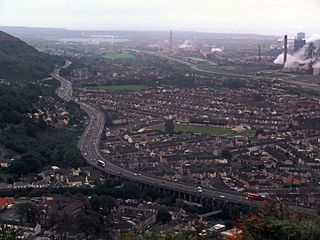
Port Talbot is a town and community in the county borough of Neath Port Talbot, Wales, situated on the east side of Swansea Bay, approximately eight miles from Swansea. The Port Talbot Steelworks covers a large area of land which dominates the south east of the town and is one of the biggest steelworks in the world but has been under threat of closure since the 1980s. The population was 37,276 in 2011.

Neath is a market town and community situated in the Neath Port Talbot County Borough, Wales. The town had a population of 50,658 in 2011. The community of the parish of Neath had a population of 19,258 in 2011. Historically in Glamorgan, the town is located on the River Neath, seven miles east-northeast of Swansea.

Neath Port Talbot is a county borough in the south-west of Wales. Its principal towns are Neath, Port Talbot, Briton Ferry and Pontardawe. The county borough borders Bridgend County Borough and Rhondda Cynon Taf to the east, Powys and Carmarthenshire to the north; and Swansea to the west.

Briton Ferry is a town and community in the county borough of Neath Port Talbot, Wales. The Welsh name may indicate that the church, llan, is protected from the wind, awel. Alternatively, Sawel may be a derivative of Saul, St Paul's earlier name. He once landed at Briton Ferry. An alternative Welsh name unused today is Rhyd y Brython, a direct translation of Briton Ferry. The Normans referred to the River crossing as La Brittonne and Leland in 1540 as Britanne Fery.
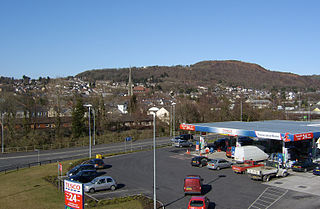
Pontardawe is a town and a community in the Swansea Valley in Wales. With a population of 6,832, it comprises the electoral wards of Pontardawe and Trebanos. A town council is elected. Pontardawe forms part of the county borough of Neath Port Talbot. On the opposite bank of the River Tawe, the village of Alltwen, part of the community of Cilybebyll, is administered separately from Pontardawe, but has close ties to the town. Pontardawe is at the crossroads of the A474 road and the A4067 road. Pontardawe came into existence as a small settlement on the northwestern bank of the Tawe where the drovers' road from Neath and Llandeilo crossed the river to go up the valley to Brecon.
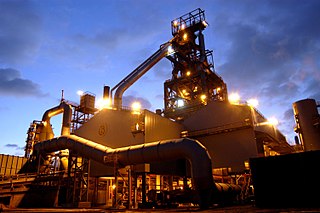
Tata Steel Europe Ltd. is a steelmaking company headquartered in London, England, with its main operations in the United Kingdom and the Netherlands. The company was created in 2007, when Tata Group took over the British-Dutch Corus Group. In 2021, the company was split into a British and a Dutch branch. Tata Steel Netherlands (TSN) and Tata Steel UK both of which fell directly under the Indian parent company Tata Steel and Tata Steel Europe ceased to exist.
The M4 corridor is an area in the United Kingdom adjacent to the M4 motorway, which runs from London to South Wales. It is a major high-technology hub. Important cities and towns linked by the M4 include London, Slough, Bracknell, Maidenhead, Reading, Newbury, Swindon, Bath, Bristol, Newport, Cardiff, Port Talbot and Swansea. The area is also served by the Great Western Main Line, the South Wales Main Line, and London Heathrow Airport. Technology companies with major operations in the area include Adobe, Amazon, Citrix Systems, Dell, Huawei, Lexmark, LG, Microsoft, Novell, Nvidia, O2, Oracle, Panasonic, SAP, and Symantec.

Llangyfelach is a village and community located in the City and County of Swansea, Wales. Llangyfelach is situated about 4 miles north of the centre of Swansea, just west of Morriston. It falls within the Llangyfelach ward. To the west is open moorland. The population was 2,510 as of the 2011 UK census. The name is seemingly derived from a combination of 'llan' and 'Cyfelach', with a mutation to combine them for Llangyfelach.

Pontarddulais, also known as Pontardulais, is both a community and a town in Swansea, Wales. It is 10 miles (16 km) northwest of the city centre. The Pontarddulais ward is part of the City and County of Swansea. Pontarddulais adjoins the village of Hendy in Carmarthenshire. The built-up population was 9,073.

Port Talbot Steelworks is an integrated steel production plant in Port Talbot, West Glamorgan, Wales, capable of producing nearly 5 million tonnes of steel slab per annum. This makes it the larger of the two major steel plants in the UK and one of the largest in Europe. Over 4,000 people work at the plant. The majority of the slab is rolled on-site at Port Talbot and at the Newport Llanwern site to make a variety of steel strip products. The remainder is processed at other Tata Steel plants or sold in slab form. The works covers a large area of land which dominates the east of the town. Its two blast furnaces and steel production plant buildings are major landmarks visible from both the M4 motorway and the South Wales Main Line when passing through the town.

Ystalyfera is a former industrial village and community in the upper Swansea Valley, on the River Tawe, about 13 miles (21 km) northeast of Swansea. It is an electoral ward and a community in the unitary authority of Neath Port Talbot, Wales, comprising a resident population of just over 3,000 people, approximately 60% of whom speak Welsh.

Machynys, or Machynys Peninsula is a coastal area just to the south of Llanelli in Carmarthenshire, Wales. In the nineteenth century an industrial community lived here working at the brickworks and tinplate works that occupied the site. When the industrial activity ceased in the mid-twentieth century, the buildings were demolished and the site lay derelict. It has now been redeveloped as a golf course as part of the Llanelli Waterside regeneration plan.
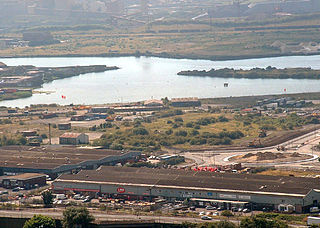
The port of Port Talbot is located on the River Afan estuary next to Port Talbot Steelworks in the industrial town of Port Talbot, South Wales. The whole basin complex covers about 500 acres (2.0 km2), consisting of: an inner set of floating docks, developed from 1834 onwards; and an outer tidal basin, completed in 1970. Owned and operated by Associated British Ports, the tidal basin has the deepest berthing facilities in the Severn estuary and is one of only a few harbours in the UK capable of handling Capesize vessels of up to 170,000 tonnes deadweight (DWT), mostly for the import of iron ore and coal for use by nearby Port Talbot Steelworks.
The City and County of Swansea is an urban centre with a largely rural hinterland in Gower; the city has been described as the regional centre for South West Wales. Swansea's travel to work area, not coterminous with the local authority, also contained the Swansea Valley in 1991; the new 2001-based version merges the Swansea, Neath & Port Talbot, and Llanelli areas into a new Swansea Bay travel to work area. Formerly an industrial centre, most employment in the city is now in the service sector.
The Steel Company of Wales Ltd was a Welsh steel and tinplate producer. It was formed in 1947 and absorbed into British Steel Corporation in 1967, British Steel then merged with Hoogovens and became Corus UK Limited. The business now forms part of Tata Steel Europe.

Llanwern steelworks is located in Llanwern, east of the City of Newport, South Wales.
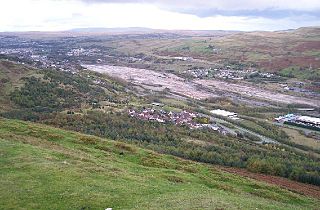
Ebbw Vale Steelworks was an integrated steel mill located in Ebbw Vale, South Wales. Developed from 1790, by the late 1930s it had become the largest steel mill in Europe. It was nationalised after World War II. As the steel industry changed to bulk handling, iron and steel making was ceased in the 1970s, and the site was redeveloped as a specialised tinplate works. It was closed by Corus in 2002, but is being redeveloped in a joint partnership between Blaenau Gwent Council and the Welsh Government.
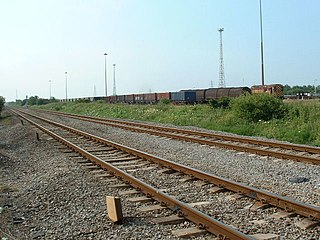
Margam Knuckle Yard is a railway yard in Margam, South Wales, on the South Wales Main Line, operated by DB Schenker Rail (UK). The yard is the major freight yard of the region, handling all of the rail freight movements from Port Talbot Steelworks, and most of the railfreight traffic around South Wales.

Trostre Steelworks is a tinplate manufacturing facility located in Pemberton, Carmarthenshire, just outside Llanelli, West Wales. Planned by the Steel Company of Wales in 1947, today it is part of Tata Steel Europe's infrastructure.

The manufacturing sector in Wales was historically centred on the mining industry, with slate, coal, tinplate and steel being important industries. Today, while traditional industries remain in smaller quantities, manufacturing in Wales is increasingly specialised and diverse, including parts of the automotive, aerospace, medical and technological industries.

















